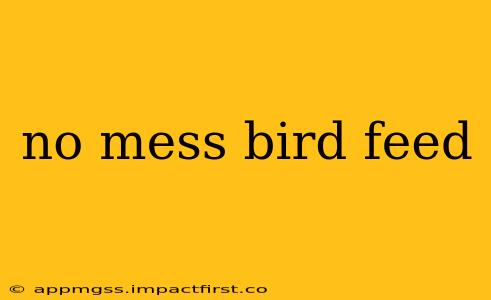Attract feathered friends to your garden without the accompanying seed scatter? It's entirely possible with the right no-mess bird feeder! Scattered seeds can attract unwanted pests, create a messy cleanup, and even deter birds from feeding if the area becomes too cluttered. This guide explores various types of no-mess feeders, their pros and cons, and how to choose the best one for your needs and feathered visitors.
What are No-Mess Bird Feeders?
No-mess bird feeders are designed to minimize seed spillage. They employ various mechanisms to keep the feed contained, preventing seeds from falling to the ground. This reduces cleanup, keeps your garden tidy, and helps prevent the spread of weed seeds from spilled birdseed. Essentially, they're a win-win for both bird enthusiasts and those who value a clean outdoor space.
Types of No-Mess Bird Feeders: A Detailed Look
Several types of bird feeders effectively minimize mess. Let's dive into the most popular options:
1. Tube Feeders with Seed Guards/Perches:
These are perhaps the most common type of no-mess feeder. The tubes hold the seed, and small perches prevent birds from clinging to the outside and scattering seeds. Some feature protective cages around the feeding ports to further prevent spillage.
Pros: Relatively inexpensive, readily available, easy to clean and refill. Cons: May not be suitable for all bird species (smaller birds might struggle), can still have minor spillage if overly full.
2. Suet Feeders:
Suet feeders, often cage-style, hold high-energy suet cakes, a favorite amongst many bird species. The cage structure keeps the suet contained, preventing messy dripping or scattering.
Pros: Attracts a wide variety of birds, especially woodpeckers and nuthatches, minimal mess. Cons: Suet can melt in hot weather, requiring careful placement and potentially frequent refills.
3. Hopper Feeders with Seed Baffles:
Hopper feeders are designed with a large reservoir that dispenses seeds through small openings. Many include seed baffles or enclosed feeding areas to prevent scattering.
Pros: Hold large quantities of seed, reducing refill frequency, good for larger flocks of birds. Cons: Can be more expensive than tube feeders, might require more thorough cleaning.
4. Platform Feeders with Covers or Sides:
While platform feeders are generally known for being messier, some models incorporate features like roofs or raised sides to offer some protection from the elements and reduce seed scattering. These are best paired with smaller seed quantities.
Pros: Ideal for ground-feeding birds, easy access for birds of various sizes. Cons: Still prone to some spillage, may need more frequent cleaning and refilling.
What Type of Bird Seed is Best for a No-Mess Feeder?
The type of birdseed can also influence the amount of mess. Smaller seeds, like niger seeds (thistle seeds), are less likely to spill than larger seeds such as sunflower seeds. However, many birds are attracted to the larger, more calorie-dense options.
How to Choose the Right No-Mess Bird Feeder for You
Consider these factors when selecting a feeder:
- Your budget: Prices vary considerably between feeder types.
- Bird species in your area: Different birds prefer different feeder types and seed sizes.
- Your available space: Choose a feeder size that fits your garden or balcony.
- Maintenance preferences: Some feeders require more frequent cleaning than others.
How Often Should I Clean My No-Mess Bird Feeder?
Regular cleaning is vital to prevent the spread of disease. Clean your feeder at least once a month, or more frequently if you notice mold, droppings, or spoiled seed.
Can I Make My Own No-Mess Bird Feeder?
While commercially available feeders offer convenience, you can also build your own! Many DIY tutorials are available online, allowing you to create a customized feeder that meets your specific needs.
By selecting the appropriate no-mess bird feeder and practicing regular cleaning, you can enjoy the beauty of birds in your garden without sacrificing cleanliness. Happy birdwatching!
